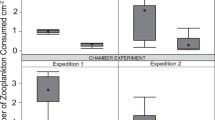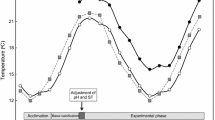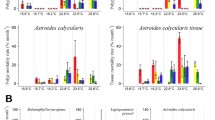Abstract
Both juvenile and adult life stages of the temperate scleractinian coral Oculina arbuscula are resilient to the effects of moderate ocean acidification (OA) in contrast to many tropical corals in which growth and calcification rates are suppressed. Here, potential mechanisms of resilience to OA related to photosynthetic physiology and inorganic carbon processing were studied in adult O. arbuscula colonies. After exposing colonies to ambient and elevated carbon dioxide (CO2) treatments for 7 weeks, photosynthetic performance was characterized using photosynthesis versus irradiance experiments, chlorophyll fluorescence kinetics, and algal pigment content. Inorganic carbon-processing capabilities were assessed by measurement of internal and external carbonic anhydrase activity of the coral host, internal carbonic anhydrase activity of symbiotic algae, and the reliance of photosynthesis on external carbonic anhydrase. Photosynthetic physiology was unaffected by OA ruling out the possibility that resilience was mediated by increased photosynthetic energy supply. Carbonic anhydrase activities were maintained at elevated CO2 suggesting no major rearrangements of the inorganic carbon-processing machinery, but this could be a sign of resilience since tropical corals often down-regulate carbonic anhydrases at high CO2. The general lack of effect of ocean acidification on these physiological traits suggests other characteristics, such as maintenance of calcifying fluid pH and ability to acquire energy from heterotrophy, may be more important for the resilience of O. arbuscula to OA.





Similar content being viewed by others
References
Aichelman HE, Townsend JE, Courtney TA, Baumann JH, Davies SW, Castillo KD (2016) Heterotrophy mitigates the response of the temperate coral Oculina arbuscula to temperature stress. Ecol Evol 6:6758–6769
Anthony KRN, Kline DI, Diaz-Pulido G, Dove S, Hoegh-Guldberg O (2008) Ocean acidification causes bleaching and productivity loss in coral reef builders. Proceedings of the National Academy of Sciences of the United States of America 105:17442–17446
Bertucci A, Tambutte S, Supuran CT, Allemand D, Zoccola D (2011) A New Coral Carbonic Anhydrase in Stylophora pistillata. Mar Biotechnol 13:992–1002
Bertucci A, Moya A, Tambutte S, Allemand D, Supuran CT, Zoccola D (2013) Carbonic anhydrases in anthozoan corals-A review. Bioorganic & Medicinal Chemistry 21:1437–1450
Bove CB, Ries JB, Davies SW, Westfield IT, Umbanhowar J, Castillo KD (2019) Common Caribbean corals exhibit highly variable responses to future acidification and warming. Proceedings of the Royal Society B-Biological Sciences 286:9
Cai WJ, Ma YN, Hopkinson BM, Grottoli AG, Warner ME, Ding Q, Hu XP, Yuan XC, Schoepf V, Xu H, Han CH, Melman TF, Hoadley KD, Pettay DT, Matsui Y, Baumann JH, Levas S, Ying Y, Wang YC (2016) Microelectrode characterization of coral daytime interior pH and carbonate chemistry. Nature Communications 7:8
Chan NCS, Connolly SR (2013) Sensitivity of coral calcification to ocean acidification: a meta-analysis. Global Change Biology 19:282–290
Cohen AL, McConnaughey TA (2003) Geochemical perspectives on coral mineralization. In: Dove PM, DeYoreo JJ, Weiner S (eds) Biomineralization. Mineralogical Soc Amer, Chantilly, pp 151–187
Comeau S, Carpenter RC, Edmunds PJ (2013) Coral reef calcifiers buffer their response to ocean acidification using both bicarbonate and carbonate. Proceedings of the Royal Society B-Biological Sciences 280:8
Comeau S, Edmunds PJ, Spindel NB, Carpenter RC (2014) Fast coral reef calcifiers are more sensitive to ocean acidification in short-term laboratory incubations. Limnology and Oceanography 59:1081–1091
Comeau S, Cornwall CE, DeCarlo TM, Krieger E, McCulloch MT (2018) Similar controls on calcification under ocean acidification across unrelated coral reef taxa. Global Change Biology 24:4857–4868
Davies SW, Marchetti A, Ries JB, Castillo KD (2016) Thermal and pCO2 Stress Elicit Divergent Transcriptomic Responses in a Resilient Coral. Frontiers in Marine Science 3:15
DeCarlo TM, Comeau S, Cornwall CE, McCulloch MT (2018) Coral resistance to ocean acidification linked to increased calcium at the site of calcification. Proceedings of the Royal Society B-Biological Sciences 285:7
Dickson AG, Goyet C (1994) DOE handbook of methods for the analysis of the various parameters of the carbon dioxide system in sea water. Version 2. ORNL/CDIAC-74
Dixon GB, Davies SW, Aglyamova GA, Meyer E, Bay LK, Matz MV (2015) Genomic determinants of coral heat tolerance across latitudes. Science 348:1460–1462
Doney SC, Fabry VJ, Feely RA, Kleypas JA (2009) Ocean Acidification: The Other CO2 Problem. Annual Review of Marine Science 1:169–192
Drake JL, Mass T, Stolarski J, Von Euw S, van de Schootbrugge B, Falkowski PG (2020) How corals made rocks through the ages. Global Change Biology 26:31–53
Edmunds PJ (2011) Zooplanktivory ameliorates the effects of ocean acidification on the reef coral Porites spp. Limnology and Oceanography 56:2402–2410
Edmunds PJ, Davies PS (1986) An energy budget for Porites porites (Scleractinia). Mar Biol 92:339–347
Edmunds PJ, Comeau S, Lantz C, Andersson A, Briggs C, Cohen A, Gattuso JP, Grady JM, Gross K, Johnson M, Muller EB, Ries JB, Tambutte S, Tambutte E, Venn A, Carpenter RC (2016) Integrating the Effects of Ocean Acidification across Functional Scales on Tropical Coral Reefs. Bioscience 66:350–362
Fuller ZL, Mocellin VJL, Morris LA, Cantin N, Shepherd J, Sarre L, Peng J, Liao Y, Pickrell J, Andolfatto P, Matz M, Bay LK, Przeworski M (2020) Population genetics of the coral Acropora millepora: Toward genomic prediction of bleaching. Science 369:268–277
Furla P, Galgani I, Durand I, Allemand D (2000) Sources and mechanisms of inorganic carbon transport for coral calcification and photosynthesis. J Exp Biol 203:3445–3457
Gates RD, Edmunds PJ (1999) The physiological mechanisms of acclimatization in tropical reef corals. Am Zool 39:30–43
Gleason DF, Harbin LR, Divine LM, Matterson KO (2018) The role of larval supply and competition in controlling recruitment of the temperate coral Oculina arbuscula. Journal of Experimental Marine Biology and Ecology 506:107–114
Grottoli AG, Rodrigues LJ, Juarez C (2004) Lipids and stable carbon isotopes in two species of Hawaiian corals, Porites compressa and Montipora verrucosa, following a bleaching event. Marine Biology 3:621–631
Grottoli AG, Rodrigues LJ, Palardy JE (2006) Heterotrophic plasticity and resilience in bleached corals. Nature 440:1186–1189
Gruber N, Clement D, Carter BR, Feely RA, van Heuven S, Hoppema M, Ishii M, Key RM, Kozyr A, Lauvset SK, Lo Monaco C, Mathis JT, Murata A, Olsen A, Perez FF, Sabine CL, Tanhua T, Wanninkhof R (2019) The oceanic sink for anthropogenic CO2 from 1994 to 2007. Science 363:1193-+
Hoadley KD, Pettay DT, Grottoli AG, Cai WJ, Melman TF, Schoepf V, Hu XP, Li Q, Xu H, Wang YC, Matsui Y, Baumann JH, Warner ME (2015) Physiological response to elevated temperature and pCO2 varies across four Pacific coral species: Understanding the unique host plus symbiont response. Sci Rep 5:15
Hofmann GE, Barry JP, Edmunds PJ, Gates RD, Hutchins DA, Klinger T, Sewell MA (2010) The Effect of Ocean Acidification on Calcifying Organisms in Marine Ecosystems: An Organism-to-Ecosystem Perspective. In: Futuyma DJ, Shafer HB, Simberloff D (eds) Annual Review of Ecology, Evolution, and Systematics, Vol 41. Annual Reviews, Palo Alto, pp 127–147
Hopkinson BM, Dupont CL, Allen AE, Morel FMM (2011) Efficiency of the CO2-concentrating mechanism of diatoms. Proceedings of the National Academy of Sciences of the United States of America 108:3830–3837
Hopkinson BM, Meile C, Shen C (2013) Quantification of extracellular carbonic anhydrase activity in two marine diatoms and investigation of its role. Plant Physiology 162:1142–1152
Hopkinson BM, Tansik AL, Fitt WK (2015) High internal carbonic anhydrase activity in the tissue of scleractinian corals is sufficient to support proposed roles in photosynthesis and calcification. J Exp Biol 218:2039–2048
Hughes TP, Anderson KD, Connolly SR, Heron SF, Kerry JT, Lough JM, Baird AH, Baum JK, Berumen ML, Bridge TC, Claar DC, Eakin CM, Gilmour JP, Graham NAJ, Harrison H, Hobbs JPA, Hoey AS, Hoogenboom M, Lowe RJ, McCulloch MT, Pandolfi JM, Pratchett M, Schoepf V, Torda G, Wilson SK (2018) Spatial and temporal patterns of mass bleaching of corals in the Anthropocene. Science 359:80–83
IPCC, 2014: Climate Change 2014: Synthesis Report. Contribution of Working Groups I, II and III to the Fifth Assessment Report of the Intergovernmental Panel on Climate Change [Core Writing Team, R.K. Pachauri and L.A. Meyer (eds.)]. IPCC, Geneva, Switzerland, 151 pp
Jokiel PL, Maragos JE, Franzisket L (1978) Coral growth: buoyant weight technique. In: Stoddart DR, Johannes RE (eds) Coral Reefs: research methods. UNESCO, Paris, France
Kaniewska P, Chan CKK, Kline D, Ling EYS, Rosic N, Edwards D, Hoegh-Guldberg O, Dove S (2015) Transcriptomic changes in coral holobionts provide insights into physiological challenges of future climate and ocean change. PloSone 10:e0139223
Koch M, Bowes G, Ross C, Zhang XH (2013) Climate change and ocean acidification effects on seagrasses and marine macroalgae. Global Change Biology 19:103–132
Kolber ZS, Prasil O, Falkowski PG (1998) Measurements of variable chlorophyll fluorescence using fast repetition rate techniques: defining methodology and experimental protocols. Biochim Biophys Acta-Bioenerg 1367:88–106
Kroeker KJ, Kordas RL, Crim RN, Singh GG (2010) Meta-analysis reveals negative yet variable effects of ocean acidification on marine organisms. Ecology Letters 13:1419–1434
Kroeker KJ, Kordas RL, Crim R, Hendriks IE, Ramajo L, Singh GS, Duarte CM, Gattuso JP (2013) Impacts of ocean acidification on marine organisms: quantifying sensitivities and interaction with warming. Global Change Biology 19:1884–1896
LaJeunesse TC, Parkinson JE, Gabrielson PW, Jeong HJ, Reimer JD, Voolstra CR, Santos SR (2018) Systematic Revision of Symbiodiniaceae Highlights the Antiquity and Diversity of Coral Endosymbionts. Curr Biol 28:2570–2580
Langdon C, Atkinson MJ (2005) Effect of elevated pCO2 on photosynthesis and calcification of corals and interactions with seasonal change in temperature/irradiance and nutrient enrichment. J Geophys Res-Oceans 110
Langdon C, Albright R, Baker AC, Jones P (2018) Two threatened Caribbean coral species have contrasting responses to combined temperature and acidification stress. Limnology and Oceanography 63:2450–2464
Leydet KP, Hellberg ME (2016) Discordant coral-symbiont structuring: factors shaping geographical variation of Symbiodinium communities in a facultative zooxanthellate coral genus, Oculina. Coral Reefs 35:583–595
Mackey KRM, Morris JJ, Morel FMM, Kranz SA (2015) Response of Photosynthesis to Ocean Acidification. Oceanography 28:74–91
Marsh JA (1970) Primary Productivity of reef-building calcareous red algae. Ecology 51:255–263
Matterson K (2012) Microscale variation in light intensity and its effects on growth of juveniles of the temperate coral, Oculina arbuscula. Georgia Southern University, p 71
Mayfield AB, Chen YJ, Lu CY, Chen CS (2018) The proteomic response of the reef coral Pocillopora acuta to experimentally elevated temperatures. PLoS One 13:24
McCulloch M, Falter J, Trotter J, Montagna P (2012) Coral resilience to ocean acidification and global warming through pH up-regulation. Nat Clim Chang 2:623–633
Miller MW (1995) Growth of a temperate coral - effects of temperature, light, depth, and heterotrophy. Mar Ecol-Prog Ser 122:217–225
Moya A, Tambutte S, Bertucci A, Tambutte E, Lotto S, Vullo D, Supuran CT, Allemand D, Zoccola D (2008) Carbonic anhydrase in the scleractinian coral Stylophora pistillata - Characterization, localization, and role in biomineralization. Journal of Biological Chemistry 283:25475–25484
Moya A, Huisman L, Ball EE, Hayward DC, Grasso LC, Chua CM, Woo HN, Gattuso JP, Foret S, Miller DJ (2012) Whole Transcriptome Analysis of the Coral Acropora millepora Reveals Complex Responses to CO2-driven Acidification during the Initiation of Calcification. Molecular Ecology 21:2440–2454
Muller EM, Sartor C, Alcaraz NI, van Woesik R (2020) Spatial Epidemiology of the Stony-Coral-Tissue-Loss Disease in Florida. Frontiers in Marine Science 7:11. https://doi.org/10.3389/fmars.2020.00163
Muscatine L, McCloskey LR, Marian RE (1981) Estimating the daily contribution of carbon from zooxanthellae to coral animal respiration. Limnology and Oceanography 26:601–611
Okazaki RR, Swart PK, Langdon C (2013) Stress-tolerant corals of Florida Bay are vulnerable to ocean acidification. Coral Reefs 32:671–682
Price NM, Harrison GI, Hering JG, Hudson RJ, Nirel PMV, Palenik B, Morel FMM (1988) Preparation and chemistry of the artificial algal culture medium Aquil. Biological Oceanography 6:443–462
Riebesell U, Zondervan I, Rost B, Tortell PD, Zeebe RE, Morel FMM (2000) Reduced calcification of marine plankton in response to increased atmospheric CO2. Nature 407:364–367
Riebesell U, Fabry VJ, Hansson L, Gattuso JP (2011) Guide to best practices for ocean acidification research and data reporting. European Commission
Ries JB, Cohen AL, McCorkle DC (2009) Marine calcifiers exhibit mixed responses to CO2-induced ocean acidification. Geology 37:1131–1134
Ries JB, Cohen AL, McCorkle DC (2010) A nonlinear calcification response to CO2-induced ocean acidification by the coral Oculina arbuscula. Coral Reefs 29:661–674
Rodolfo-Metalpa R, Martin S, Ferrier-Pages C, Gattuso JP (2010) Response of the temperate coral Cladocora caespitosa to mid- and long-term exposure to pCO2 and temperature levels projected for the year 2100 AD. Biogeosciences 7:289–300
Sawall Y, Hochberg EJ (2018) Diel versus time-integrated (daily) photosynthesis and irradiance relationships of coral reef organisms and communities. PLoS One 13:13
Sevilgen DS, Venn AA, Hu MY, Tambutte E, de Beer D, Planas-Bielsa V, Tambutte S (2019) Full in vivo characterization of carbonate chemistry at the site of calcification in corals. Sci Adv 5:9
Silverman D (1982) Carbonic anhydrase: oxygen-18 exchange catalyzed by an enzyme with rate-contributing proton-transfer steps. Methods in enzymology 87:732–752
Stachowicz JJ, Hay ME (1999) Mutualism and coral persistence: The role of herbivore resistance to algal chemical defense. Ecology 80:2085–2101
Strader ME, Wong JM, Hoffman GE (2020) Ocean acidification promotes broad transcriptomic responses in marine metazoans: a literature survey. Frontiers in Zoology 17
Tambutte S, Holcomb M, Ferrier-Pages C, Reynaud S, Tambutte E, Zoccola D, Allemand D (2011) Coral biomineralization: From the gene to the environment. Journal of Experimental Marine Biology and Ecology 408:58–78
Tansik AL, Fitt WK, Hopkinson BM (2015) CO2 uptake facilitated by an extracellular carbon anhydrase is critical for photosynthesis in symbiotic corals. Coral Reefs 34:703–713
Tansik AL, Fitt WK, Hopkinson BM (2017) Inorganic carbon is scarce for symbionts in scleractinian corals. Limnology and Oceanography 62:2045–2055
Thornhill DJ, Kemp DW, Bruns BU, Fitt WK, Schmidt GW (2008) Correspondence between cold tolerance and temperate biogeography in a western atlantic Symbiodinium (Dinophyta) lineage. Journal of Phycology 44:1126–1135
Thrane JE, Kyle M, Striebel M, Hannde S, Grung M, Rohrlack T, Andersen T (2015) Spectrophotometric Analysis of Pigments: A Critical Assessment of a High-Throughput Method for Analysis of Algal Pigment Mixtures by Spectral Deconvolution. PLoS One 10:e0137645
Tortell PD, Payne CD, Li YY, Trimborn S, Rost B, Smith WO, Riesselman C, Dunbar RB, Sedwick P, DiTullio GR (2008) CO2 sensitivity of Southern Ocean phytoplankton. Geophys Res Lett 35
Towle EK, Enochs IC, Langdon C (2015) Threatened Caribbean Coral Is Able to Mitigate the Adverse Effects of Ocean Acidification on Calcification by Increasing Feeding Rate. PLoS One 10:17
Trotter J, Montagna P, McCulloch M, Silenzi S, Reynaud S, Mortimer G, Martin S, Ferrier-Pages C, Gattuso J-P, Rodolfo-Metalpa R (2011) Quantifying the pH ‘vital effect’ in the temperate zooxanthellate coral Cladocora caespitosa: Validation of the boron seawater pH proxy. Earth Planet Sci Lett 303:163–173
Varnerin BV, Hopkinson BM, Gleason DF (2020) Recruits of the temperate coral Oculina arbuscula mimic adults in their resilience to ocean acidification. Mar Ecol-Prog Ser 636:63–75
Venn AA, Tambutte E, Holcomb M, Laurent J, Allemand D, Tambutte S (2013) Impact of seawater acidification on pH at the tissue-skeleton interface and calcification in reef corals. Proceedings of the National Academy of Sciences of the United States of America 110:1634–1639
Xue L, Cai WJ, Hu XP, Sabine C, Jones S, Sutton AJ, Jiang LQ, Reimer JJ (2016) Sea surface carbon dioxide at the Georgia time series site (2006-2007): Air-sea flux and controlling processes. Prog Oceanogr 140:14–26
Zaneveld JR, Burkepile DE, Shantz AA, Pritchard CE, McMinds R, Payet JP, Welsh R, Correa AMS, Lemoine NP, Rosales S, Fuchs C, Maynard JA, Thurber RV (2016) Overfishing and nutrient pollution interact with temperature to disrupt coral reefs down to microbial scales. Nature Communications 7:12
Zhang HN, Byrne RH (1996) Spectrophotometric pH measurements of surface seawater at in situ conditions: Absorbance and protonation behavior of thymol blue. Mar Chem 52:17–25
Acknowledgements
This work was supported by an Institutional Grant (NA18OAR4170084) to the Georgia Sea Grant College Program from the National Sea Grant Office, National Oceanic and Atmospheric Administration, US Department of Commerce. We are grateful to M. Head, T. Recicar, and K. Roberson at Gray’s Reef National Marine Sanctuary for providing logistical support for specimen collection. Oculina arbuscula were collected under the auspices of a letter of acknowledgement from the National Marine Fisheries Service, Southeast Regional Office, St. Petersburg, FL.
Author information
Authors and Affiliations
Corresponding author
Ethics declarations
Conflict of interest
On behalf of all authors, the corresponding author states that there is no conflict of interest.
Additional information
Publisher's Note
Springer Nature remains neutral with regard to jurisdictional claims in published maps and institutional affiliations.
Topic Editor Anastazia Teresa Banaszak
Electronic supplementary material
Below is the link to the electronic supplementary material.
Rights and permissions
About this article
Cite this article
Wang, C., Arneson, E.M., Gleason, D.F. et al. Resilience of the temperate coral Oculina arbuscula to ocean acidification extends to the physiological level. Coral Reefs 40, 201–214 (2021). https://doi.org/10.1007/s00338-020-02029-y
Received:
Accepted:
Published:
Issue Date:
DOI: https://doi.org/10.1007/s00338-020-02029-y




